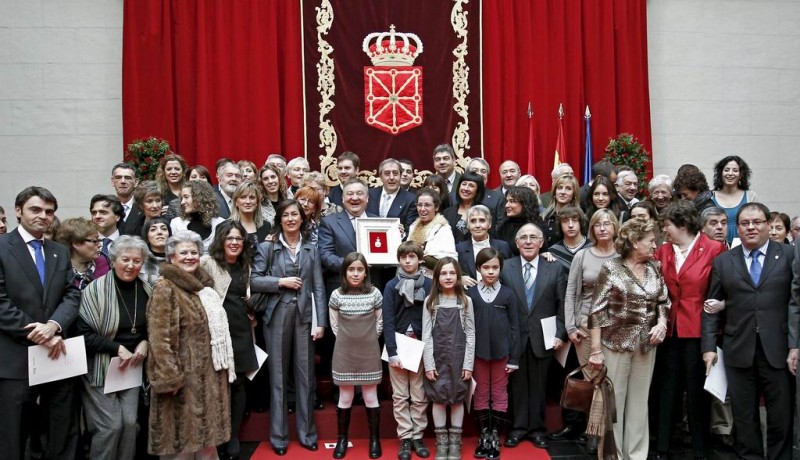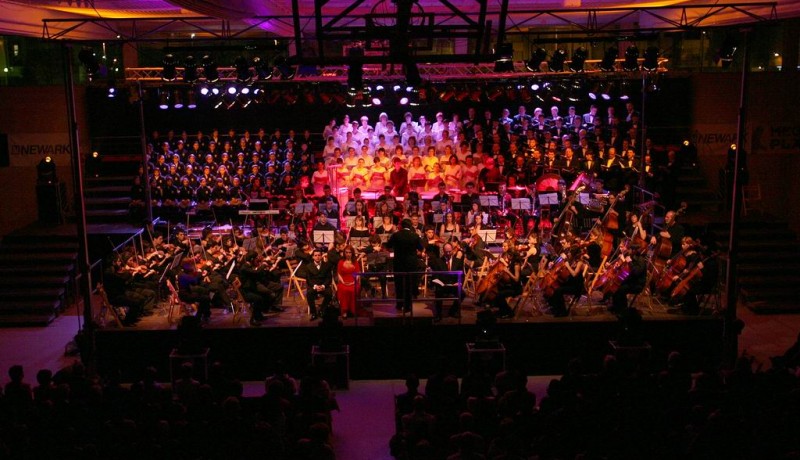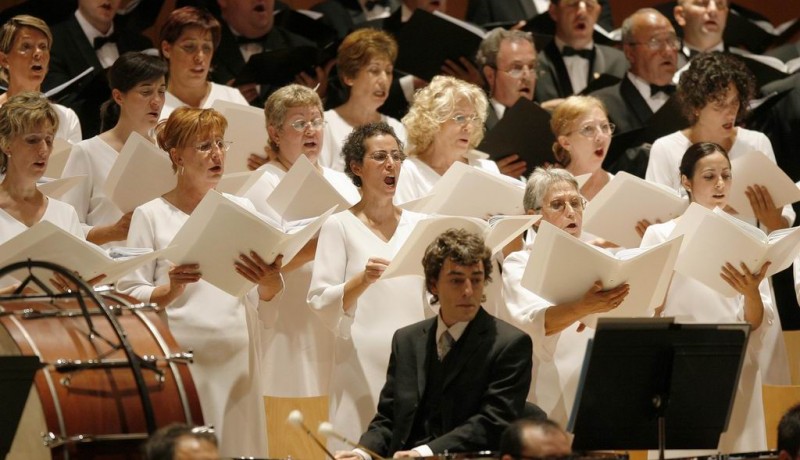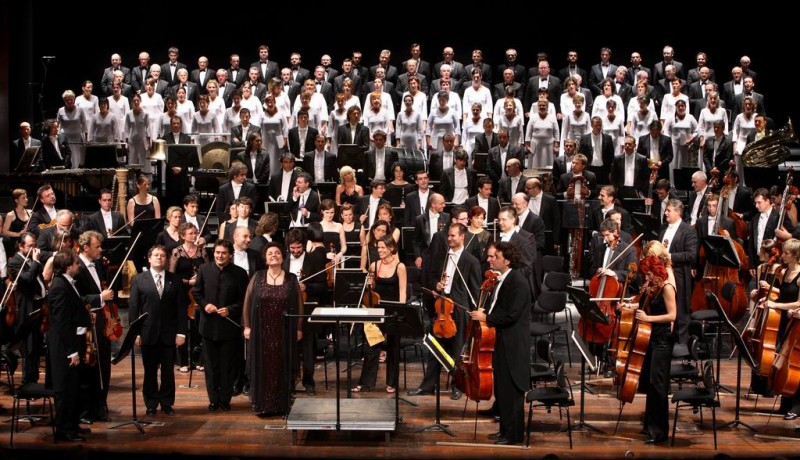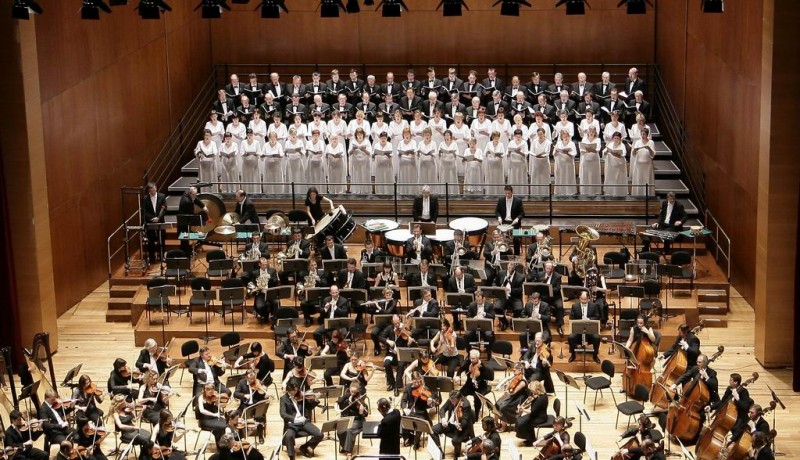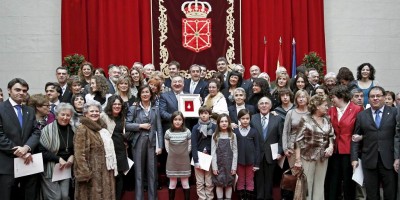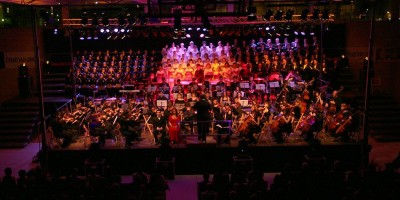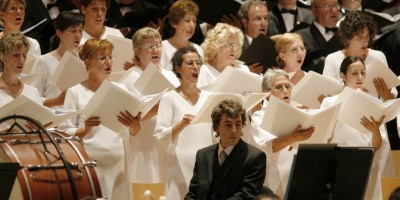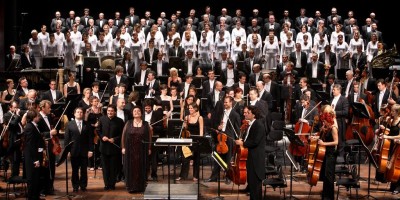History
Stages
1865-1891
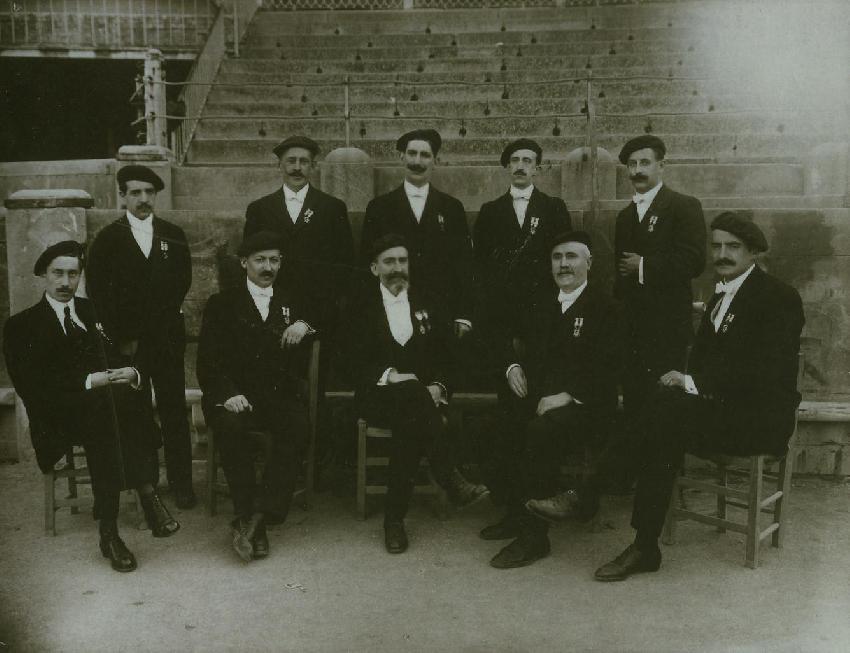
The history of the Orfeón Pamplonés dates back to 1865, the year in which its eleven founding members, headed by Conrado García, created a Choral Society called Orfeón Pamplonés with the intention of teaching music to those singers who apply and are accepted (Minutes 1865).
The Director of that first Orfeón, in which an extremely young Julián Gayarre sang, was Joaquín Maya.
From the earliest days of the Orfeón Pamplonés, intellectually and socially distinguished members of Pamplona’s high society sat on the successive Boards of Directors (Jacinto Campión as Chairman, Serafín Mata y Oneca as Secretary).
Leading figures from the world of music, such as Joaquín Gaztambide, Emilio Arrieta, Hilarión Eslava, Juan Guelbenzu and Dámaso Zabalza, were named Honorary Members during these years.
1873 saw an end to that initial Orfeón, chiefly for financial reasons. The Minutes state that there were not enough members to cover the society’s most basic costs.
On the 6th of November 1881, a group belonging to Pamplona's social and intellectual elite relaunched the disbanded the Orfeón Pamplonés in line with the trend at the time for athenaeums and the Society was renamed the Ateneo Orfeón Pamplonés. Its programmes combined musical performances with literary events, such as talks and conferences, poetry recitals, drama and even magic shows. Fidel Maya served as the Ateneo Orfeón Pamplonés’ Musical Director and the writer Serafín Mata y Oneca acted as its Secretary. The Ateneo Orfeón faced countless problems as a result of not having suitable premises of its own, a circumstance which led to serious internal divisions.
In 1885, the group’s activity was suspended indefinitely due to poor attendance at rehearsals and it was finally decided that it should be dismantled two years later.
What would become the definitive Orfeón Pamplonés first saw the light of day, albeit briefly, when a group intent on reforming the society, headed by Fidel Maya, met on the 28th of August 1890.
The new Board’s first decision was to name Pablo Sarasate, not just a friend of the Society and an advisor to it, but also one of its most active collaborators, Honorary Chairman. On the 4th of March 1891, a young tenor who belonged to Pamplona Cathedral's music chapel, Remigio Múgica, was named Assistant Director. On the 27th of the same month, Fidel Maya announced that he was leaving for Gijón for work reasons and, on his recommendation and with the approval of the Board of Directors, Remigio was made Provisional Director of the Orfeón. However, poor attendance at rehearsals led to what was to be the last suspension of the choir's activity on the 30th of April the same year.
1892-1948
Publication in the press of an upcoming choir competition to be held in Bilbao led to the definitive reincarnation of the Orfeón Pamplonés in May 1892. Remigio Múgica brought together all the old members and successfully encouraged new voices to join the choir. In August of the same year, the Orfeón Pamplonés won all the competition categories it entered. A few months later, it played an active part in what was known as the Gamazada, the popular reaction to the proposed termination of Navarre’s special status within Spain, thereby acquiring great prestige among the local population.
Remigio Múgica raised the category of the Orfeón Pamplonés to that of grand choir, following the 19th-century trend among major choral formations in European cities to form part of local philharmonic societies as orphéons, groups initially consisting only of male voices (male choirs and, on occasions, boys' choirs). The Orfeón won prizes in practically all the competitions in which it took part: Bilbao (1892 and 1896), Santander (1893), Valladolid (1894), San Sebastián (1902), Bordeaux (1904), Zaragoza (1905). It also travelled to places like Barcelona (1895 and 1902), San Sebastián (1894) and Madrid (1897), receiving magnificent reviews and performing before the royal family on a number of occasions.
Between 1893 and 1908, the Orfeón sang alongside the Santa Cecilia Orchestra and Pablo Sarasate in the concerts organised by Pamplona City Council to celebrate the San Fermín festival. These concerts brought the Orfeón both funds and prestige. Also, thanks to Sarasate’s influence, it started to tackle symphonic works.
Women had played a part in the Orfeón practically ever since it started, participating on special occasions (Zarzuela choruses, lyrical galas, etc.). But in 1903 the role of women in the Orfeón was consolidated when the “Ladies’ Choir” was formed, making the Orfeón Pamplonés one of the first mixed choirs in Spain.
The inclusion of female voices marked a significant step forwards, allowing it to address large-scale symphonic works.
In 1906, the Orfeón Pamplonés performed at the wedding of King Alfonso XIII and Victoria Eugenie of Battenberg in Madrid’s Church of Los Jerónimos. The assassination attempt on the couple following the ceremony meant that a number of events scheduled to be held in the capital were called off and the Society fell into financial crisis. The crisis worsened when Pablo Sarasate died in 1908 and the San Fermín concerts were gradually dropped from the festival programme. The Orfeón hardly left Pamplona over the next ten years, although it should be mentioned that it performed its first ever opera in 1913: Jesús Guridi’s Mirentxu.
In 1918, the Orfeón Pamplonés once again won the Choral Society Competition of Oviedo and in 1919 it took part in its last choral society competition, which was held in Bilbao. The Orfeón won.
In the 1920s, under the baton of Múgica and with Fernández Arbós fronting the Madrid Symphony Orchestra, the Orfeón undertook several significant musical collaboration projects. In 1923, it performed for the first time several numbers from Brahms’ A German Requiem and the Bacchanal from Ravel’s Daphnis et Chloé, both of which it went on to perform again the same year in Biarritz. In 1924, it sang Roger-Ducasse’s Sarabande, Beethoven’s Ninth Symphony, Bruckner’s Te Deum (for the first time in the Romance language-speaking world according to the Orfeón’s records) and the Dances from Borodin’s Prince Igor. 1925 saw the Orfeón perform Fauré’s Requiem for the first time and it went on to sing Bach’s Magnificat in 1926.
In 1927, the Orfeón and Arbós’ Madrid Symphony Orchestra took part in the events held to mark the hundredth anniversary of the death of Beethoven with a set of concerts in Madrid's Monumental Cinema, singing the composer’s Missa Solemnis and Ninth Symphony before an audience which included the highest authorities of the day. These concerts served as a springboard for the Orfeón, which, exploiting the success of the Missa Solemnis and Ninth Symphony, started to travel all around Spain.
In 1928, Maurice Ravel conducted the Orfeón Pamplonés’ performance of his Three Songs for Unaccompanied Mixed Choir: Nicolette, Trois beaux oiseaux du paradis and Ronde (1915).
Over the following years, despite the adverse political situation in Spain (including the Civil War), the Orfeón managed to remain a modern choir, embracing new works, including pieces from Early Music (Tomás Luis de Victoria, Guerrero, etc.).
1948-1973
D. Martín Lipúzcoa
The founder’s years of glory and prestige were followed by those of his successor, Martín Lipúzcoa, who led the Orfeón over a period (1948 - 1956) in which the Society regularly performed in Madrid, Barcelona, Valladolid and the Basque Country, reaching as far as Palma de Mallorca and Portugal.
What would become the Orfeón’s classic standard repertoire gradually took shape: Mozart’s, Brahms’, Verdi’s and Fauré’s Requiems, Bach’s Passions and Beethoven’s Ninth.
The creation of the Quartet of Vocal Soloists (consisting of members of the Orfeón) helped to further requests for a choir whose Contralto soloist, Sagrario Aramburu, shared stages with some of the most important figures of the day.
D. Juan Eraso
Juan Eraso headed the Orfeón Pamplonés from 1956 to 1960, years in which he implanted a style of his own within the field of choral music, applying more modern voice-projection techniques and taking the Orfeón to a degree of vocal perfection that would allow it to perform a multitude of concerts without musical accompaniment.
During this time, French venues opened their doors to the Orfeón: Saint-Émilion, Bordeaux, Toulouse, Bayonne and even Paris, where the choir sang the Mozarabic Rite and recorded Cristóbal Halffter’s Ducal Mass. This recording led to other fruitful collaborations with Halffter, who was named an Honorary Director of the Institution.
D. Pedro Pírfano
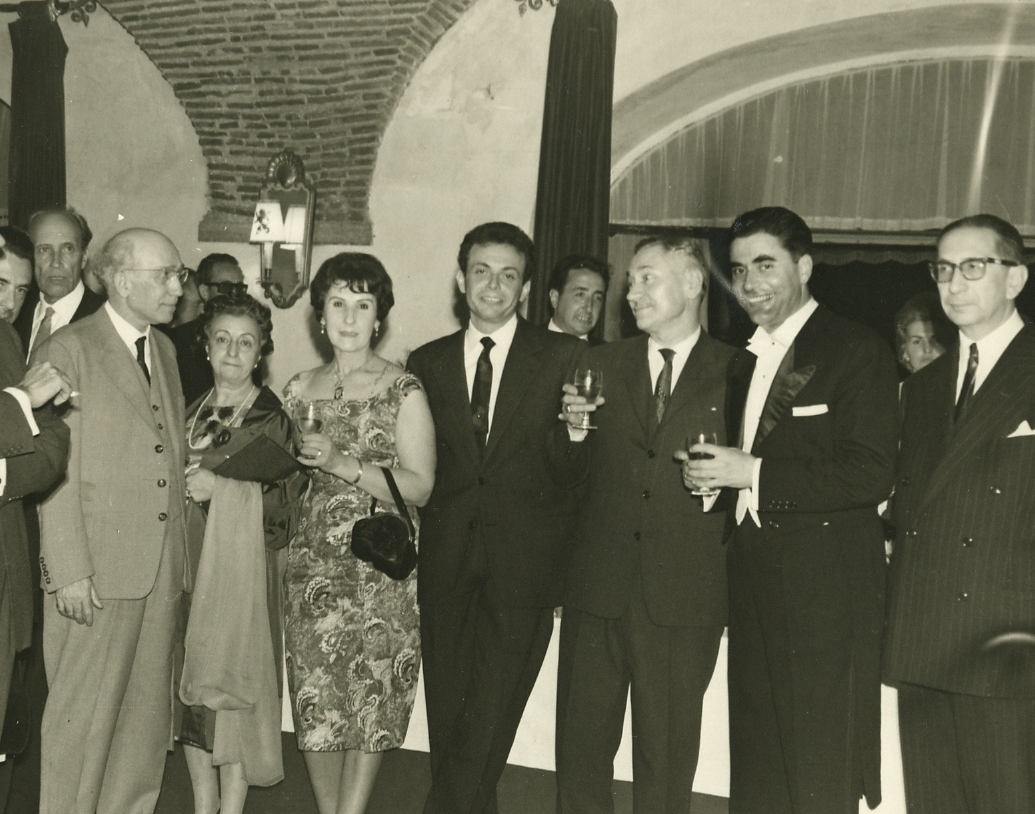
Pedro Pírfano led the Orfeón from 1960 to 1967. Over the seven-year period in which he directed the Orfeón Pamplonés, Pírfano took it to many of the great music festivals held in Spain and abroad. Under his direction, the choir took part in the prestigious Gulbenkian festival in Portugal, performing works such as Beethoven’s Ninth Symphony and Missa Solemnis, the Mai Musical de Bordeaux, the La Rochelle Festival and Granada’s International Music and Dance Festival. During this time, the Orfeón travelled to the Netherlands, with Willem Van Oterloo conducting the Hague Philharmonic, and Portugal, where Lorin Maazel fronted the National Symphony Orchestra in Lisbon.
Musically speaking, Pedro Pírfano was both innovative and adventurous. He premiered works by Navarrese composers and also brought some of the works of composers like Stravinsky and Hindemith to Spain for the first time. Pírfano also introduced pieces by Spanish Renaissance polyphonists.
Pedro Pírfano opened the Orfeón up to avant-garde works, but did not neglect the great choral-symphonic works and even managed to combine the two with more popular local pieces. During this period in its history, the Orfeón travelled all over Navarre and took part in countless concerts of a more folkloric nature with local bands, dance groups and txistu (Basque fipple flute) players.
D. Carmelo LLorente
The arrival of Carmelo Llorente (1967-1973) heralded a period which would see little change in the Orfeón, which largely maintained the repertoire and collaboration arrangements it inherited from Lipúzcoa, and continued to attend prestigious festivals, such as the Gulbenkian.
In 1969, just one year on from its world premiere in New York, the Orfeón Pamplonés premiered Cristóbal Halffter’s Yes, Speak Out, yes cantata in Spain. During this period, the Orfeón performed works such as Mahler’s Eighth Symphony and Mendelssohn’s oratorio Elijah for the first time.
1973-1993
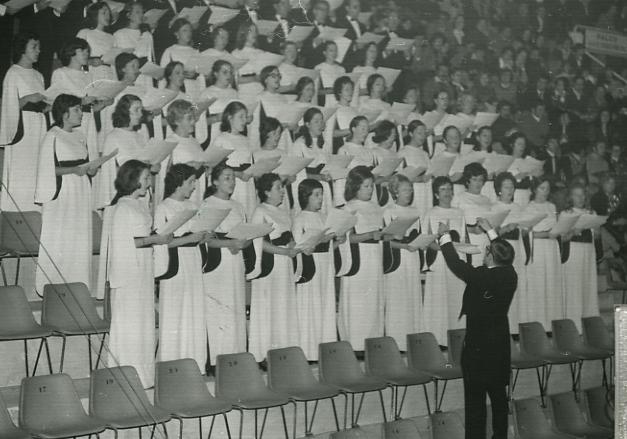
During its twenty year period (1973-1993) under the direction of José Antonio Huarte, the Orfeón made the most of the boom in international summer festivals: Strasbourg, Montpellier, Avignon, Orange, Paris’ Salle Pléyel, the Mai Musical de Bordeaux, Porto and Lisbon, among others.
The Orfeón played all the major concert halls and theatres in Spain: Barcelona’s Palau de la Música, Madrid’s Auditorio and Teatro Real, Teatro de la Maestranza in Seville, Bilbao’s Arriaga, Victoria Eugenia in San Sebastián, Granada’s Palacio de Carlos V and other venues and festivals in Santander, Vitoria, Cuenca, Santiago de Compostela, Valencia, Palma de Mallorca and, of course, Pamplona.
To commemorate its centenary, taking the date of the first international prize the Society received as a basis (International Choral Society Competition of Bilbao, 1892), the Orfeón received numerous awards and other types of official recognition. The Ministry of Culture awarded it the Silver Medal for merit in the Fine Arts and it also received the Príncipe de Viana Culture Award presented by Prince Felipe of Spain.
José Antonio Huarte’s departure brought an end to a period of splendour, which was followed by a number of years in which different maestros headed the Orfeón for brief stints.
1992-2005
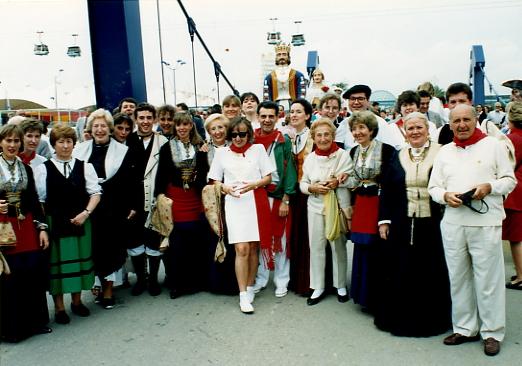
Under these three Directors (Juan Carlos Múgica, 1993-1996, Koldo Pastor, 1996-1997, and Pascual Aldave, 1997-1998), the Orfeón began to redefine itself, both as an institution and in terms of its artistic path. These maestros brought in new techniques, added new works to the repertoire and even premiered some of their own works, their all coming from composing backgrounds. They brought the local musical avant-garde to Navarrese audiences.
Director from 1998 to 2005, Alfonso Huarte was the first to have a professional management team. The Institution was completely overhauled during this period, both in terms of its structure and the choir itself, allowing the Orfeón Pamplonés once again to access the finest venues around: International festivals (Peralada, Ruhr, San Sebastián’s Musical Fortnight), Auditorio Nacional, Kursaal, Euskalduna, Príncipe de Asturias, Baluarte, etc.
2005-present
Igor Ijurra became Artistic Director of the Orfeón Pamplonés in 2005. The choir first crossed the Atlantic in 2007 with a tour of Mexico, performing at venues such as Mexico City’s Palacio de Bellas Artes and Guadalajara’s Teatro Degollado, among others. Although a period of internationalisation had begun, the Orfeón managed to combine this with premieres and performances of works by local composers, attempting to take music not only to major symphonic venues, but also to each and every corner of Navarre.
In 2010, the Orfeón became the first Spanish choir to perform at New York’s prestigious Carnegie Hall and went on to play some of the United States’ chief venues. The hoir also performed at Washington Kennedy Center.
2012 would see the Orfeón back in the United States, with Frühbeck de Burgos fronting the New York Philharmonic Orchestra in the Lincoln Center. It performed Falla’s Atlántida and Orff’s Carmina Burana, proving a great success with audiences and receiving good reviews in the media, including the New York Times.
From 2009 to 2014, the Orfeón took Orff’s Carmina Burana, with mise-en-scène by La Fura dels Baus, on tour in search of new audiences. From its premiere in San Sebastián’s Musical Fortnight onwards, this unique version of Carmina Burana was warmly received by audiences and critics alike at all the venues at which it was performed: Kursaal, Auditori de Barcelona, Pamplona’s Baluarte, Victor Villegas in Murcia and Oviedo’s Teatro Campoamor. The Orfeón also took it to the Lyon Festival (Nuits de Fourvière), the International Music Festival of the Canary Islands, Chile and the Maggio Musicale Fiorentino.
Over this period, the Orfeón has taken part in the seasons of Spain’s leading orchestras and has even played a part in the Spanish stages of tours by foreign orchestras. It has started to appear at some of Europe’s largest festivals once again, such as the Chorégies d'Orange, and took part in a programme for French television in 2014.
2015 marked the 150th Anniversary of the Orfeón Pamplonés. The year got under way with a tour of Verdi’s Requiem with Vladimir Jurowski and the London Philharmonic Orchestra which included concerts at London’s Royal Festival Hall, Madrid’s Auditorio Nacional, Baluarte in Pamplona and the Théâtre des Champs-Élysées in Paris. On the 19th of March, the exact date of its anniversary, it performed Beethoven’s Ninth Symphony with the Mariinsky Orchestra, conducted by Valéry Gergiev.
It recorded Dvořák’s Mass in D major and Te Deum with the Navarre Symphony Orchestra, conducted by Antoni Wit, for the Naxos label.
On the 1st of August, it performed at the prestigious BBC Proms in London with the BBC Philharmonic Orchestra, conducted by Juanjo Mena.

